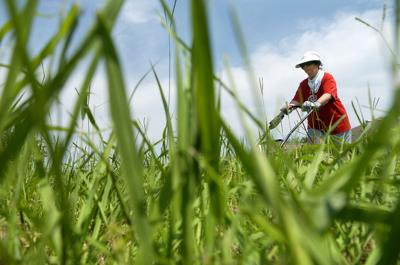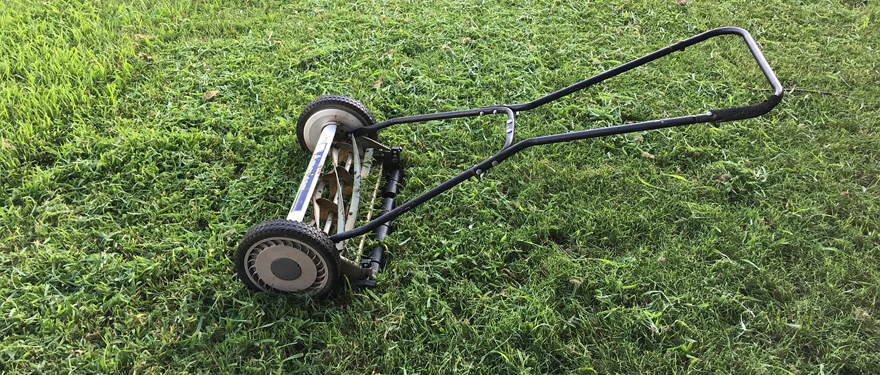Featured
Table of Contents
Learn More About Sage
Individuals worried about look can opt for a mulching lawn mower, he recommended, as those cut lawn finely. Still, lawn cut with a rotary lawn mower won't stay for long."Grass clippings are made of very soft tissue that decays rapidly," Mann said. While letting lawn clippings lie is best, there are 2 reasons you might want to obtain them.
Second, never let yard clippings blow into roadways or walkways, due to the fact that healthy or not the grass blades high in nutrients can trigger problems for sewage systems and waterways. Here are a few other tips for trimming your yard the very best method: "The sharpness of the blade is vital," Mann stated. People cutting with a dull blade are shredding their yard instead of appropriately cutting it, which leaves space for fungis to attack.
Sometimes, it can cause grass to pass away. Changing the mower blade or sharpening it as soon as a year can avoid that. The majority of turf varieties throughout the nation prosper at 2.5 to 3 inches, however some, such as those in Florida, may like to be cut shorter or taller, Mann stated. If you're unsure of for how long to leave your lawn, consult a landscape professional about what varieties of grass are growing in your yard.
This information was put together by Anoka County. For extra recyclers in your location, search online. Any recycler wanting to be included to this list might contact recycle@co.anoka.mn.us!.?.!. The information supplied in this directory is assembled as a service to homeowners. A listing in this directory does not imply recommendation or approval by Anoka County.
My son has been attempting to construct out of 3 large piles of turf included by plastic fencing. With all the rain we've had, the stacks have actually become wet, compacted, dense and really heavy. What can be done to make these stacks more reliable at breaking down? They have been turned, however we recently added a great deal of grassand that plus the rain has actually made things a compressed mess.
That should be really fantastic for the garden ... no?-- Elizabeth in North Plainfield, New Jersey "No" is appropriate, Elizabeth. 'Green manure' is a crop that you grow to plow into the ground as living fertilizer. What your son has is just a huge green smelly mess. (Really, THREE big green stinky messes.) This is a typical error for novice composters, especially in the summertime, when yard clippings are plentiful.
Those clippings are EXTREMELY high in Nitrogenabout 10%. That's basically the same level you 'd discover in truly HOT manures, like bat and bird guano. In the easiest sense, these Nitrogen abundant parts don't become the compost in a pile; instead they provide food for the billions of little microbes that fuel the process of turning the other stuffthe so-called 'dry browns' that must make up a minimum of 80% of a pileinto the garden gold our plants so long for.
Learn More About Perennials
The benefit of including things like lettuce leaves, apple cores and broccoli stalks to a garden compost stack or is primarily in the relaxing of your recycling conscience, not in their capability to develop high quality garden compost. Now you can utilize clippings to make great compost, but to do so you have to blend percentages of well-shredded yard clippings in with big quantities of well-shredded leaves.
(The very best compost piles follow the Goldilocks guideline: Not too wet and not too dry. Great deals of air flow too. I understand, Goldilocks didn't mention air flow. However she ought to have.) Anyhow, the outcome of such an honorable enterprise is the elusive, much sought-after garden amendment called "hot garden compost". Compost that formulate quickly with the assistance of a natural source of high Nitrogen is far better food for your plants and supplies far more life for your soil.
And it's the best kind for making compost tea. "Cold compost"the stuff that results when you simply pile a great deal of things up, wish for the finest and really get some finished product after a year or socan be a good plant food and soil improver, however hot garden compost is FAR BETTER.

I fear that your big stacks of slimy damp lawn clippings will not improve one bit with the passage of time. Just the opposite in truth. Ah, however your timing is good to get it right, as we are quick approaching autumn leaf fall. Let lots of leaves gather on the lawn during a drought (do not let damp leaves collect), go over them with a lawn mower, bag up what ought to be an ideal mix of lots of wonderfully shredded leaves and a percentage of well-shredded grass and after that empty this mix into a big wire cage, a slatted wood bin, a or something else to hold all of it in location good and cool.
(Individuals who inform you to 'layer' the components in a compost pile failed physics.) Yes, this will only utilize a little percentage of the clippings produced by the average lawn, and that's a good idea. Since outside of that fall leaf drop window, you must NOT be bagging your turf clippings.
I utilize "quotes" since there's no 'mulch' of any kind involved here. A poor name for an outstanding instrument of sustainability, mulching mowers pulverize clippings into a nearly unnoticeable powder that they then return to your lawn. A powder that's 10% Nitrogen; about as high a natural number as you can get.
DON'T utilize any clippings from an herbicide-treated yard in a compost pile. A few of the powerful chemicals in usage today can survive even hot composting and might kill any plants that receive the garden compost later. Oh, and stop using that toxic things too!!!.
Read More About Gardens
The Department of Public Functions provides core civil services for the security and convenience of the citizens of Dayton. These important services-- consisting of Civil Engineering, Fleet Management, Parks and Forestry, Street Maintenance, and Waste Collection-- all improve Dayton's quality of life. Click among the links to the left to explore featured services provided by Public Works.

What can I state? Lawn clippings are important to composting. But you require to find out how to do it effectively so both your yard and garden compost bin enjoy! Many property owners rapidly understand that their compost bin or system can not handle all that lawn! The following details will help you to much better comprehend how to recycle those turf clippings.
So, let's start there. Forget those long-held beliefs that yard clippings left on a lawn smother the yard underneath or cause thatch. Grass clippings are actually great for the yard. From now on, do not bag your lawn clippings: "yard cycle" them. Grasscycling is a simple, easy opportunity for every single homeowner to do something great for the environment.
And the best part is, it takes less time and energy than bagging and dragging that lawn to the curb. Like the fellow in the image to the left, you may even take your grass clippings out for a Sunday bicycle flight; now that's grasscycling taken to the extreme! Grasscycling, simply put, is the practice of leaving lawn clippings on the yard or using them as mulch.
Lawn clippings add water-saving mulch and encourage natural soil aeration by earthworms. No bagging or raking the lawn (Whew!) Plastic lawn bags do not wind up in the garbage dump 50% of your yard's fertilizer needs are fulfilled, so you reduce time and money spent fertilizing Less contaminating: reduces the need for fertilizer, pesticides and herbicides Non-thatch causing, thus making a lawn energetic and resilient Makes you feel good and green all over! Yahoozy! Not just does it make looking after your yard easier, however grasscycling can also lower your mowing time by 50% since you don't have to select up afterwards.
To grasscycle appropriately, cut the lawn when it's dry and constantly keep your lawn mower blades sharp. Remove no more than 1/3 of the leaf surface area with each mowing. Mow when the lawn is dry. Use a sharp lawn mower blade. A dull lawn mower blade swellings and tears the yard plant, leading to a ragged, tarnished look at the leaf suggestion.
In the spring, lease an aerator which eliminates cores of soil from the lawn. This opens up the soil and permits higher movement of water, fertilizer, and air by increasing the speed of decay of the grass clippings and enhancing deep root growth. Water thoroughly when needed. During the driest duration of summer season, yards require at least one inch of water every five to 6 days.
Learn More About Flowers
Lawn clippings, being mainly water and very rich in nitrogen, are bothersome in compost bins because they tend to compact, increasing the opportunity of becoming soggy and discharging a strong ammonia-like smell. Follow these pointers for composting this valuable "green", thereby lessening odor and matting, and increasing fast decomposition:, intermixed in a 2-to-1 ratio with "brown" products such as dry leaves or plant debris (saving/bagging Fall's leaves is perfect for Spring/Summer grass composting). That's an average of seven hours per season. Heck, that's a day at the beach!. No unique lawn mower is needed. For best results, keep the lawn mower blade sharp and mow only when the lawn is dry. When clippings disintegrate, they launch their nutrients back to the yard. They include nitrogen, potassium and phosphorus, in addition to lesser amounts of other important plant nutrients.
There's no polluting run-off, no usage of non-renewable resources and no damage to soil organisms or wildlife. The expense of trucking lawn clippings to landfill websites comes out of residents' taxes. This is a wasteful practice: all those nutrient-rich clippings could be fertilizing individuals's lawns, thereby saving money on fertilizers and water expenses.
Grasscycling is an accountable ecological practice and an opportunity for all homeowners to decrease their waste. And the very best part is, it takes less time and energy than bagging and dragging that lawn to the curb. Today, 58 million Americans invest roughly $30 billion every year to keep over 23 million acres of yard.
The exact same size plot of land could still have a small lawn for entertainment, plus produce all of the vegetables required to feed a household of six. The yards in the United States take in around 270 billion gallons of water a week: enough to water 81 million acres of natural veggies, all summer season long.
farmland, or roughly the size of the state of Indiana. Yards use ten times as many chemicals per acre as commercial farmland. These pesticides, fertilizers, and herbicides run into our groundwater and vaporize into our air, triggering extensive pollution and worldwide warming, and greatly increasing our threat of cancer, cardiovascular disease, and birth flaws.
In truth, yards use more equipment, labor, fuel, and agricultural toxic substances than industrial farming, making lawns the largest farming sector in the United States. However it's not simply the property lawns that are lost on turf. There are around 700,000 athletic premises and 14,500 golf courses in the United States, a lot of which used to be fertile, efficient farmland that was lost to developers when the regional markets bottomed out.
To mow correctly, a number of issues need to be considered: height, frequency, clipping removal, and blade sharpness. The chart below identifies the most common varieties of turfgrass grown in yards, and the height to set your lawn mower. Read the ideas listed below for additional guidelines. Kentucky Bluegrass 2.5-3.5" 4" Fine/Tall Fescue 2.5-3.5" 4" Seasonal Ryegrass 2.5-3" 4" Bermudagrass.5-1" 2" Zoysia.5-1" 2": Under the majority of circumstances, lawns ought to be mown at 2.5-3-inches.
Latest Posts
9045 Horticultural Tips
9064 Flower Garden Tips And Tricks
2561 Gardening Tips And Hints